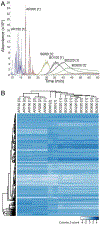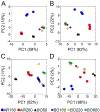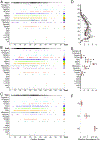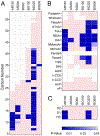Characterization of Compositional Variability in Petroleum Substances
- PMID: 35250041
- PMCID: PMC8896784
- DOI: 10.1016/j.fuel.2022.123547
Characterization of Compositional Variability in Petroleum Substances
Abstract
In the process of registration of substances of Unknown or Variable Composition, Complex Reaction Products or Biological Materials (UVCBs), information sufficient to enable substance identification must be provided. Substance identification for UVCBs formed through petroleum refining is particularly challenging due to their chemical complexity, as well as variability in refining process conditions and composition of the feedstocks. This study aimed to characterize compositional variability of petroleum UVCBs both within and across product categories. We utilized ion mobility spectrometry (IMS)-MS as a technique to evaluate detailed chemical composition of independent production cycle-derived samples of 6 petroleum products from 3 manufacturing categories (heavy aromatic, hydrotreated light paraffinic, and hydrotreated heavy paraffinic). Atmospheric pressure photoionization and drift tube IMS-MS were used to identify structurally related compounds and quantified between- and within-product variability. In addition, we determined both individual molecules and hydrocarbon blocks that were most variable in samples from different production cycles. We found that detailed chemical compositional data on petroleum UVCBs obtained from IMS-MS can provide the information necessary for hazard and risk characterization in terms of quantifying the variability of the products in a manufacturing category, as well as in subsequent production cycles of the same product.
Conflict of interest statement
Declaration of interests The authors declare that they have no known competing financial interests or personal relationships that could have appeared to influence the work reported in this paper.
Figures








References
-
- Kaiser MJ, A review of refinery complexity applications, Pet Sci, 14 (2017) 167–194.
-
- Salvito D, Fernandez M, Jenner K, Lyon DY, de Knecht J, Mayer P, MacLeod M, Eisenreich K, Leonards P, Cesnaitis R, Leon-Paumen M, Embry M, Deglin SE, Improving the Environmental Risk Assessment of Substances of Unknown or Variable Composition, Complex Reaction Products, or Biological Materials, Environ Toxicol Chem, 39 (2020) 2097–2108. - PMC - PubMed
-
- CONCAWE, REACH – Analytical characterisation of petroleum UVCB substances, in, Brussels, Belgium, 2012.
-
- Clark CR, McKee RH, Freeman JJ, Swick D, Mahagaokar S, Pigram G, Roberts LG, Smulders CJ, Beatty PW, A GHS-consistent approach to health hazard classification of petroleum substances, a class of UVCB substances, Regulatory toxicology and pharmacology : RTP, 67 (2013) 409–420. - PubMed
-
- ECHA, Guidance for identification and naming of substances under REACH and CLP, in, European Chemical Agency, Helsinki, Finland, 2017.
Grants and funding
LinkOut - more resources
Full Text Sources
Other Literature Sources
